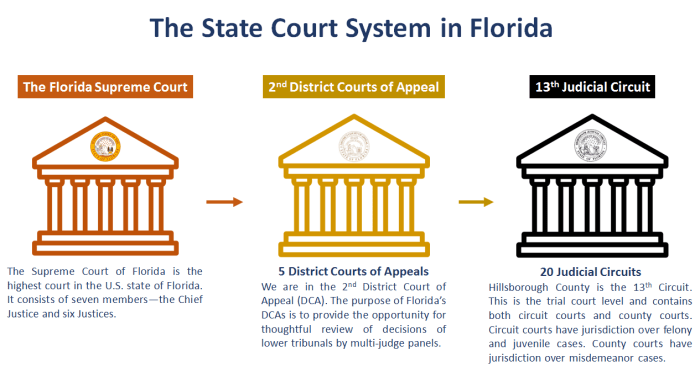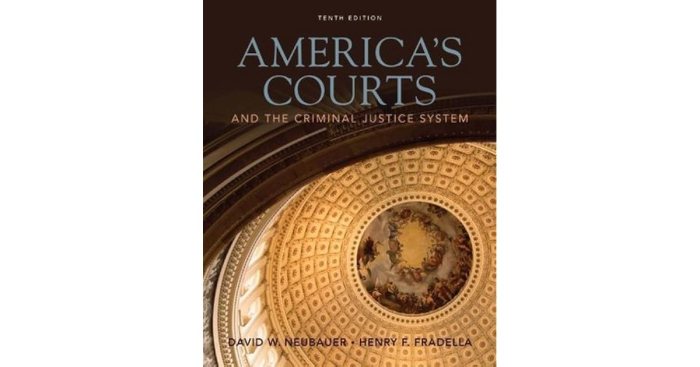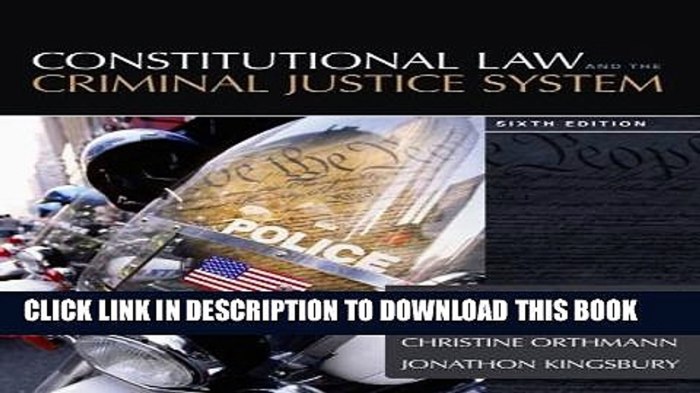America’s courts and the criminal justice system 13th edition – America’s Courts and the Criminal Justice System, 13th Edition, offers a comprehensive and engaging examination of the American judicial system and its intricate interplay with the criminal justice process. This authoritative text provides a thorough understanding of the historical evolution, structural organization, and practical application of America’s courts, empowering readers to critically analyze the challenges and reforms shaping this dynamic system.
Throughout the text, readers will delve into the historical foundations of America’s courts, exploring the key principles and landmark cases that have molded their development. They will gain a clear understanding of the structure and organization of the American court system, encompassing federal, state, and local courts, and the jurisdiction and responsibilities of each level.
The book meticulously examines the intricate steps involved in the criminal justice process, from arrest to sentencing, highlighting the roles of law enforcement, prosecutors, defense attorneys, and judges.
Historical Context of America’s Courts and the Criminal Justice System

The American court system and criminal justice system have evolved significantly since the nation’s founding. The roots of the system can be traced back to the colonial era, when English common law and legal principles were transplanted to the American colonies.
Key principles and values that have shaped the development of the criminal justice system include due process, equal protection under the law, and the right to a fair trial. These principles have been enshrined in the Constitution and Bill of Rights, and have been further developed through landmark Supreme Court cases.
Landmark Cases
- Marbury v. Madison(1803): Established the principle of judicial review, giving courts the power to declare laws unconstitutional.
- Gideon v. Wainwright(1963): Guaranteed the right to an attorney for all criminal defendants, regardless of their ability to pay.
- Miranda v. Arizona(1966): Required law enforcement to inform suspects of their rights before questioning them.
Structure and Organization of America’s Courts

The American court system is a complex and hierarchical structure. There are three main levels of courts: federal courts, state courts, and local courts.
Federal Courts
- Supreme Court:The highest court in the land, with the power to interpret the Constitution and strike down laws that violate it.
- Circuit Courts of Appeals:13 intermediate appellate courts that review decisions from lower federal courts.
- District Courts:Trial courts that handle most federal criminal and civil cases.
State Courts
- State Supreme Courts:The highest courts in each state, with the power to interpret state laws and constitutions.
- Intermediate Appellate Courts:In some states, there are intermediate appellate courts that review decisions from lower state courts.
- Trial Courts:Handle most criminal and civil cases in the state.
Local Courts
- Municipal Courts:Handle minor criminal offenses and civil disputes within a city or town.
- Justice of the Peace Courts:Handle minor offenses and civil disputes in rural areas.
Judicial Selection and Appointment
The process of judicial selection and appointment varies depending on the level of court. Federal judges are appointed by the President and confirmed by the Senate. State judges are typically elected by voters or appointed by the governor.
The Criminal Justice Process
The criminal justice process begins with an arrest and proceeds through various stages, including investigation, prosecution, trial, and sentencing.
Steps in the Criminal Justice Process
- Arrest:A person is taken into custody by law enforcement for a suspected crime.
- Booking:The arrested person is processed and charged with a crime.
- Initial Appearance:The arrested person appears before a judge, who informs them of their rights and sets bail.
- Pretrial Hearing:The defense and prosecution present evidence and arguments to determine whether the case should proceed to trial.
- Trial:A jury or judge hears evidence and determines the guilt or innocence of the defendant.
- Sentencing:If the defendant is found guilty, the judge imposes a sentence.
- Law Enforcement:Investigate crimes, make arrests, and enforce the law.
- Prosecutors:Represent the government in criminal cases and seek to convict the defendant.
- Defense Attorneys:Represent the defendant and protect their rights.
- Judges:Preside over trials, rule on legal issues, and impose sentences.
- Right to a Fair Trial:The right to be tried by an impartial jury and to have the assistance of an attorney.
- Right to Due Process:The right to be informed of the charges against them, to confront witnesses, and to present a defense.
- Right to be Presumed Innocent:The prosecution must prove guilt beyond a reasonable doubt.
- Imprisonment:Confinement in a jail or prison.
- Probation:Supervision by a probation officer while living in the community.
- Parole:Early release from prison under supervision.
- Fines:Monetary penalties.
- Severity of the Crime
- Defendant’s Criminal History
- Victim Impact
- Defendant’s Age and Health
- Defendant’s Rehabilitation Potential
- Mass Incarceration:The United States has the highest incarceration rate in the world.
- Racial Disparities:Black and Hispanic people are disproportionately represented in the criminal justice system.
- Ineffective Sentencing Laws:Some argue that current sentencing laws are too harsh and do not adequately promote rehabilitation.
- Lack of Funding:Courts and correctional facilities are often underfunded.
- Sentencing Reform:Reducing mandatory minimum sentences and expanding the use of alternative sentencing options.
- Bail Reform:Eliminating cash bail and replacing it with risk-assessment tools.
- Police Accountability:Implementing measures to increase police accountability and reduce police brutality.
- Increased Funding:Providing more funding for courts and correctional facilities to improve conditions and services.
Roles in the Criminal Justice Process
Rights of the Accused, America’s courts and the criminal justice system 13th edition
Sentencing and Corrections

Sentencing is the process by which a judge imposes a punishment on a convicted criminal. The type of sentence imposed depends on a variety of factors, including the severity of the crime, the defendant’s criminal history, and the judge’s discretion.
Types of Sentences
Factors Considered in Sentencing
Correctional Programs
Correctional programs aim to rehabilitate offenders and reduce recidivism. These programs include education, job training, and substance abuse treatment.
Challenges and Reforms in America’s Courts and Criminal Justice System
The American court system and criminal justice system face a number of challenges, including:
Proposed reforms to address these challenges include:
Common Queries: America’s Courts And The Criminal Justice System 13th Edition
What are the key principles that have shaped the development of America’s criminal justice system?
Due process of law, equal protection under the law, the right to a fair trial, the presumption of innocence, and the right to counsel are among the key principles.
What are the different levels of courts in the American court system?
The American court system comprises three primary levels: federal courts, state courts, and local courts, each with varying jurisdictions and responsibilities.
What are the factors that judges consider when determining sentences?
Judges consider various factors when determining sentences, including the nature and severity of the crime, the defendant’s criminal history, and the potential for rehabilitation.